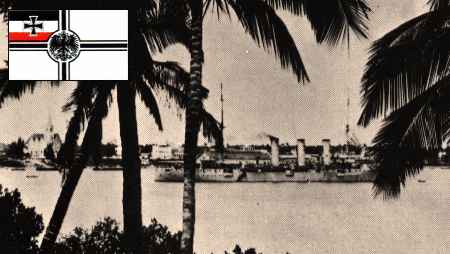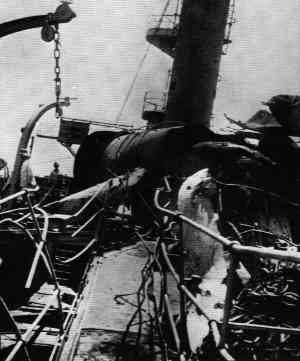Konigsberg. A German East African Raider
 |
| Konigsberg at Dar-es-Salaam. |
Contributed by Kevin Patience
email: kjpatience@hotmail.com.
|
In the upper reaches of the Rufiji River delta in what is now Tanzania lie the rusting remains of the Imperial German Navy cruiser Konigsberg and its attendant fuelling collier Somali; both destroyed by gunfire from Royal Navy vessels during the early stages of the First World War. These relics mark the site of a curious drama that took place against the inhospitable backdrop of an obscure East African river. Konigsberg was one of a new class of fast well armed cruisers built in the years before the First World War. Launched in 1906 the ship served in the Baltic fleet and acted as escort to the Kaisers Royal Yacht Hohenzollern before being laid up at Kiel in 1912. In late 1913 the German Colony in East Africa with its capital of Dar es Salaam had requested a suitable replacement for the elderly sail and steam corvette SMS Gier then on station. In June the following year a sleek powerful recommissioned Konigsberg commanded by Fregatten Kapitan Max Loof arrived as a symbol of naval power in the region. The Royal Navy squadron based at Simonstown under Rear Admiral King-Hall in South Africa could only offer three out dated cruisers of 1890's vintage and the arrival of this modern warship posed a threat to the regions maritime trade especially should war be declared. Towards the end of July 1914 with political unrest in Europe leading to war Konigsberg like her sister ship Emden in the Far East prepared for a new role as a sea raider and left Dar es Salaam for the high seas followed shortly after by the collier Somali. On 4 August war was declared but Konigsberg's career as a raider lasted only a few weeks due to a combination of coal shortage and mechanical defects. After sailing north to the Gulf of Aden the cruiser captured and later sank the City of Winchester, the first British merchant ship casualty of the war. Despite the additional coal from the Winchester, the supply aboard the Somali was soon exhausted and at the end of August Loof was forced her to seek shelter in the muddy backwaters of the Rufiji River delta south of Dar es Salaam awaiting further supplies. After two weeks sufficient coal had been taken aboard for an attempt to be made to return to Germany via the Cape of Good Hope with the intention of capturing allied ships en route for additional supplies. On the day of departure Loof received a telegram concerning a British cruiser anchored at Zanzibar some 150 miles up the coast. Not missing a chance to strike a blow at the enemy, the cruiser sailed over night arriving at Zanzibar early the following morning. Shortly before dawn the crew of H.M.S. Pegasus were awakened by the sound of heavy gunfire. Out ranged and out gunned Pegasus was rapidly put out of action and in a brief 45 minute bombardment Konigsberg reduced the ship to a wreck which sank later that day with the loss of 38 lives. Konigsberg turned and headed south for the cape, but within hours suffered a major engine failure and was forced to return to the delta once again. The damaged parts were removed and taken overland through the bush to Dar es Salaam where new items were fabricated by the railway workshops. The loss of the Pegasus brought the full force of the Royal Navy's efforts to seek out and destroy the menacing raider and within days three large cruisers were searching the coastline for clues as to its whereabouts. Five weeks later Konigsberg was discovered in the river five miles inland preparing to leave having completed repairs. A blockade was mounted to prevent the raider escaping while plans were formulated to destroy the warship. The original idea had been to bomb the target but after two farcical attempts with underpowered ancient seaplanes and tiny bombs the decision was made to use shallow draft gunboats. Two ex Brazilian Navy river monitors were towed from the Mediterranean to Zanzibar where they were prepared. On the morning of 6 July the two monitors sailed into the delta under heavy fire and took up positions five miles down stream from the Konigsberg which had since moved twelve miles upstream. Using two aircraft to spot the fall of shell the monitors opened fire. By midday some damage had been inflicted on the raider before the falling tide necessitated withdrawal. Five days later a second attempt was more successful. Severely damaged by the monitors fire Loof scuttled the ship and signalled Berlin "Konigsberg is destroyed but not conquered." Its ghost lived on in the shape of its ten 4 inch guns that reappeared to shell the Allies during the land campaign led by Colonel Von Lettow Vorbeck. Ten months had passed before Konigsberg's destruction by the then revolutionary use of spotter aircraft in cooperation with surface vessels. Although not as successful as the Emden, Konigsberg had occupied the Royal Navy for nearly a year tying up twenty ships and ten aircraft and consuming nearly forty thousand tons of coal. After the war Commander Ingles, former Captain of Pegasus bought the wreck of the Konigsberg for £200 and salvaged a large quantity of non ferrous metal from the ship. The wreck remained in the river until 1962 when a salvage contract was awarded and the remains cut up for scrap. Today there is little to be seen other than a few pieces of metal in the bushes. The Somali slowly corrodes away under an umbrella of mangrove trees invisible to all but the keenest eye while Pegasus has now become a popular dive site. The largest relics of Konigsberg to survive are a pair of 4 inch guns, one in Mombasa, Kenya and the other in Pretoria, South Africa. By a strange coincidence the Mombasa gun stands next to one from the Pegasus. Both had been salvaged from the respective wrecks and both were to see action against one another on land having fought a one sided action at Zanzibar.
Kevin Patience, author of a number of books and articles on East African military and transport history, published Konigsberg - A German East African Raider in 1997, which tells the full story from the launching to the present day, illustrated with numerous photographs many of which have never been published before. Available from the Author at kjpatience@hotmail.com. Hardback, 120 pages, 150 illustrations including rare photos, maps and appendices. UK £15 inc P&P elsewhere US $ 30 inc P&P |

